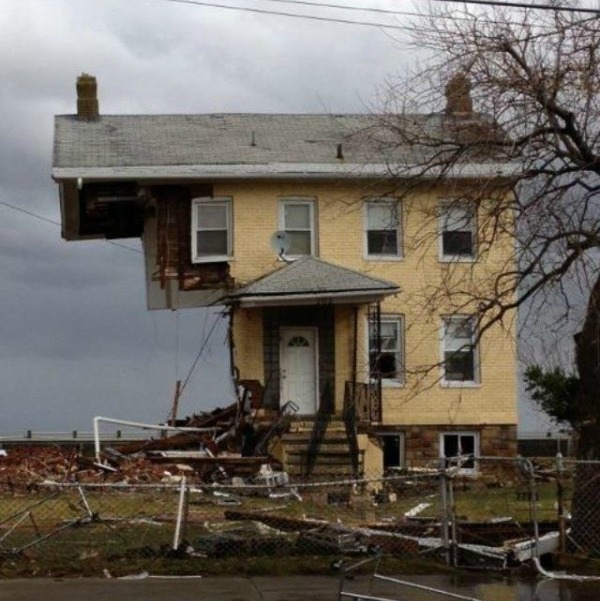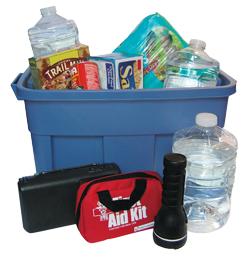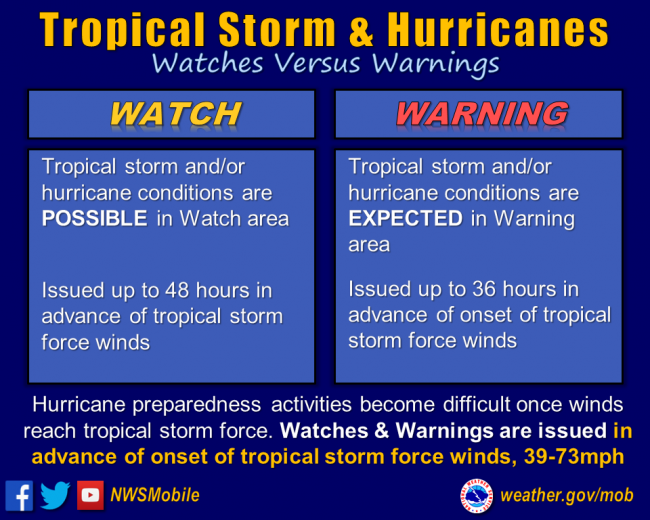

In 2012, Hurricane Sandy destroyed this house in Jersey Shore, New Jersey. Sandy was the 2nd-costliest hurricane on record in the U.S. until 2017, when both Harvey and Maria surpassed it. Image via Shayna Marie Meyer.
June 1 is the start of the Atlantic hurricane season each year. The season ends on November 30. No one can predict exactly how many hurricanes we’ll get in a season, or how powerful they’ll be. Last year’s hurricane season was unusually intense. In 2018, scientists at NOAA’s Climate Prediction Center are forecasting a 75-percent chance for an Atlantic hurricane season that’s near- or above-normal, thanks in part to a weak El Niño. In the Eastern Caribbean and along the U.S. East Coast, the season tends to be busiest between mid-August and mid-September. Now, early in the season, is the time to make a plan to stay safe if a hurricane approaches your area.
If you live along the U.S. East Coast or Gulf of Mexico – and don’t have a plan – I hope this post will prepare you. Sit down with your family and figure something out, now.

Be prepared. Image via National Hurricane Center.
How to create a supply kit. According to the National Hurricane Center, your family should have a supply kit. The kit includes:
- One gallon of water per person daily for up to a week.
- Food for a week. Canned food and juices work really well. Make sure you have a manual can opener and other utensils needed for cooking food.
- Blankets and pillows
- Clothing (including clothing that is water resistant)
- First aid kit, medications, prescription drugs
- Toiletries, hygiene items, moisture wipes, hand sanitizer and soap
- Flashlight and batteries
- NOAA weather radio
- Cash, because debit and credit cards might not work
- Full tank of gas/extra gasoline
- Pet care items such as food, water, muzzle, leash, and a cage.
- Charged cellphone
- Matches or lighter
- If you have babies, make sure you have a decent supply of baby food, diapers, etc.
Also, if you live along the coast, make sure you have the supplies (such as plywood) to board up windows to protect your house. Get plywood now instead of 2-3 days before a storm hits.
Figure out what needs to be taken inside in case floods or strong winds pick up any of your belongings.
Develop an evacuation plan now.

Image via Weather Station Advisor
If a hurricane is imminent … First, understand the difference between watches and warnings. Hurricane watches mean hurricane conditions (74 mile per hour winds or greater) are possible within 48 hours. Hurricane warnings means hurricane conditions are expected. If a hurricane is imminent …
Turn down your freezer and refrigerator to the coldest settings possible. If you lose electricity, your perishable foods will last longer.
Turn off propane tanks and small electrical appliances.
Consider whether you really want to stay at your house. The worst damage from hurricanes usually comes from storm surge and flooding. However, stronger hurricanes can produce violent winds that can cause damage to buildings and structures. Also, tropical systems are capable of producing small tornadoes. Do you want all of these possible impacts to threaten you and your family?
Pay careful attention to hurricane forecasts. Sometimes, Mother Nature can be unpredictable. A forecast Category One hurricane could end up being a strong Category Two, causing more damage than predicted. If you see hurricane watches or warnings for your area, that should be enough to influence you to leave. Do you have relatives that you can visit? Don’t be a brave soul and weather out the storm.

Galveston, Texas. Hurricane of 1900. Image via NOAA
More links and other things to consider. Is your house in an area prone to flooding? If so, do you have flood insurance for your house? Check out Floodsmart.gov if you do not have flood insurance.
How does your community prepare for a hurricane? Is there a certain procedure the city follows in case of an evacuation?
The Red Cross has more information about being prepared for a hurricane.
The National Hurricane Center also has excellent information about hurricane preparedness and safety.
Meteorologists’ main goal is to not only accurately forecast the weather, but to protect lives. They offer watches and warnings to prepare the public for life-threatening storms. Please do not ignore watches or warnings! Take every storm seriously. Hope for the best, but expect the worst.
Bottom line: June 1 is the start of the 2018 hurricane season. Are you prepared for a hurricane if one approaches your area? If you live along the Gulf of Mexico or East Coast and don’t have a plan, this post can help you prepare.
Hurricane Survival Tips: How to Stay Safe During a Hurricane
9 Affordable Ways to Prep Your Home for Hurricane Season
Disaster Preparedness for Pets
Enjoying EarthSky? Sign up for our free daily newsletter today!
from EarthSky https://ift.tt/1kprFqm


In 2012, Hurricane Sandy destroyed this house in Jersey Shore, New Jersey. Sandy was the 2nd-costliest hurricane on record in the U.S. until 2017, when both Harvey and Maria surpassed it. Image via Shayna Marie Meyer.
June 1 is the start of the Atlantic hurricane season each year. The season ends on November 30. No one can predict exactly how many hurricanes we’ll get in a season, or how powerful they’ll be. Last year’s hurricane season was unusually intense. In 2018, scientists at NOAA’s Climate Prediction Center are forecasting a 75-percent chance for an Atlantic hurricane season that’s near- or above-normal, thanks in part to a weak El Niño. In the Eastern Caribbean and along the U.S. East Coast, the season tends to be busiest between mid-August and mid-September. Now, early in the season, is the time to make a plan to stay safe if a hurricane approaches your area.
If you live along the U.S. East Coast or Gulf of Mexico – and don’t have a plan – I hope this post will prepare you. Sit down with your family and figure something out, now.

Be prepared. Image via National Hurricane Center.
How to create a supply kit. According to the National Hurricane Center, your family should have a supply kit. The kit includes:
- One gallon of water per person daily for up to a week.
- Food for a week. Canned food and juices work really well. Make sure you have a manual can opener and other utensils needed for cooking food.
- Blankets and pillows
- Clothing (including clothing that is water resistant)
- First aid kit, medications, prescription drugs
- Toiletries, hygiene items, moisture wipes, hand sanitizer and soap
- Flashlight and batteries
- NOAA weather radio
- Cash, because debit and credit cards might not work
- Full tank of gas/extra gasoline
- Pet care items such as food, water, muzzle, leash, and a cage.
- Charged cellphone
- Matches or lighter
- If you have babies, make sure you have a decent supply of baby food, diapers, etc.
Also, if you live along the coast, make sure you have the supplies (such as plywood) to board up windows to protect your house. Get plywood now instead of 2-3 days before a storm hits.
Figure out what needs to be taken inside in case floods or strong winds pick up any of your belongings.
Develop an evacuation plan now.

Image via Weather Station Advisor
If a hurricane is imminent … First, understand the difference between watches and warnings. Hurricane watches mean hurricane conditions (74 mile per hour winds or greater) are possible within 48 hours. Hurricane warnings means hurricane conditions are expected. If a hurricane is imminent …
Turn down your freezer and refrigerator to the coldest settings possible. If you lose electricity, your perishable foods will last longer.
Turn off propane tanks and small electrical appliances.
Consider whether you really want to stay at your house. The worst damage from hurricanes usually comes from storm surge and flooding. However, stronger hurricanes can produce violent winds that can cause damage to buildings and structures. Also, tropical systems are capable of producing small tornadoes. Do you want all of these possible impacts to threaten you and your family?
Pay careful attention to hurricane forecasts. Sometimes, Mother Nature can be unpredictable. A forecast Category One hurricane could end up being a strong Category Two, causing more damage than predicted. If you see hurricane watches or warnings for your area, that should be enough to influence you to leave. Do you have relatives that you can visit? Don’t be a brave soul and weather out the storm.

Galveston, Texas. Hurricane of 1900. Image via NOAA
More links and other things to consider. Is your house in an area prone to flooding? If so, do you have flood insurance for your house? Check out Floodsmart.gov if you do not have flood insurance.
How does your community prepare for a hurricane? Is there a certain procedure the city follows in case of an evacuation?
The Red Cross has more information about being prepared for a hurricane.
The National Hurricane Center also has excellent information about hurricane preparedness and safety.
Meteorologists’ main goal is to not only accurately forecast the weather, but to protect lives. They offer watches and warnings to prepare the public for life-threatening storms. Please do not ignore watches or warnings! Take every storm seriously. Hope for the best, but expect the worst.
Bottom line: June 1 is the start of the 2018 hurricane season. Are you prepared for a hurricane if one approaches your area? If you live along the Gulf of Mexico or East Coast and don’t have a plan, this post can help you prepare.
Hurricane Survival Tips: How to Stay Safe During a Hurricane
9 Affordable Ways to Prep Your Home for Hurricane Season
Disaster Preparedness for Pets
Enjoying EarthSky? Sign up for our free daily newsletter today!
from EarthSky https://ift.tt/1kprFqm

Aucun commentaire:
Enregistrer un commentaire